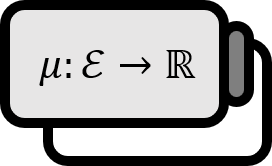Predictable Functions
Definition1
Let’s call $(X, \mathcal{E})$ a measurable space. Let’s define the set $S_{f}(\alpha)$ as follows.
$$ S_{f}(\alpha):=\left\{ x\in X\ |\ f(x) >\alpha \right\} = f^{-1}\left( (\alpha, \infty) \right),\quad \forall \alpha \in \mathbb{R} $$
If for every real number $\alpha \in \mathbb{R}$, $S_{f}(\alpha) \in \mathcal{E}$ holds, then the function $f : X \to \overline{\mathbb{R}}$ taking extended real values is called $\mathcal{E}$-measurable or simply measurable.
Explanation
Especially, if $X=\mathbb{R}$, it is called Lebesgue measurable. When determining whether a function is measurable or not, it’s useful to check if it conforms to the above definition, and there’s a useful theorem for that.
Theorem
For the function $f : X \to \overline{\mathbb{R}}$, the following four conditions are equivalent:
- (a) For every $\alpha \in \mathbb{R}$, $A_{\alpha} = S_{f}(\alpha) =\left\{ x\in X : f(x) > \alpha \right\}$ $\in$ $\mathcal{E}$.
- (b) For every $\alpha \in \mathbb{R}$, $B_{\alpha}=\left\{ x\in X : f(x) \le \alpha \right\}$ $\in$ $\mathcal{E}$.
- (c) For every $\alpha \in \mathbb{R}$, $C_{\alpha}=\left\{ x\in X : f(x) \ge \alpha \right\}$ $\in$ $\mathcal{E}$.
- (d) For every $\alpha \in \mathbb{R}$, $D_{\alpha}=\left\{ x\in X : f(x) < \alpha \right\}$ $\in$ $\mathcal{E}$.
Proof
First, since $A_{\alpha}$ and $B_{\alpha}$ are complements of each other, according to the property of σ-algebra (D2), (a) and (b) are equivalent. Similarly, (c) and (d) are equivalent. Therefore, showing that (a) and (c) are equivalent completes the proof.
Let’s say the set $X$ is given. A collection $\mathcal{E} \subset \mathcal{P}(X)$ of subsets of $X$ that satisfies the below conditions is called a $\sigma$-algebra:
- (D1) $\varnothing, X \in \mathcal{E}$
- (D2) $E \in \mathcal{E} \implies E^c \in \mathcal{E}$
- (D3) $E_{k} \in \mathcal{E}\ (\forall k \in \mathbb{N}) \implies \bigcup_{k=1}^\infty E_{k} \in \mathcal{E}$
- (D4) $E_{k} \in \mathcal{E}\ (\forall\ k \in \mathbb{N}) \implies \bigcap_{k=1}^\infty E_{k} \in \mathcal{E}$
(a) $\implies$ (c)
Assuming condition (a) holds, for every $n\in \mathbb{N}$, $A_{\alpha-\frac{1}{n}}\in\mathcal{E}$ holds. And $C_{\alpha}=\bigcap_{n=1}^\infty A_{\alpha-\frac{1}{n}}$. Therefore, by definition (D3) of the $\sigma$-algebra, $C_{\alpha} \in \mathcal{E}$ holds.
(c) $\implies$ (a)
Assuming condition (c) holds, for every $n\in \mathbb{N}$, $C_{\alpha+\frac{1}{n}}\in\mathcal{E}$ holds. And $A_{\alpha}=\bigcup_{n=1}^\infty C_{\alpha+\frac{1}{n}}$. Therefore, by definition (D3) of the $\sigma$-algebra, $A_{\alpha} \in \mathcal{E}$ holds.
■
Robert G. Bartle, The Elements of Integration and Lebesgue Measure (1995), p8 ↩︎
